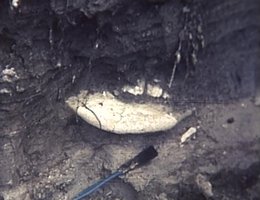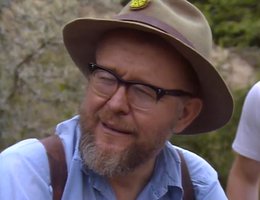

In 1971, University of Nebraska State Museum paleontologist Michael Voorhies was walking with his wife Jane through a series gullies on Melvin Colson’s farm in northeastern Nebraska. What had attracted Voorhies to this area was that the Verdigre Creek and its tributaries had done a good job of eroding away the top layers of much of the land around the area. Voorhies had been searching the area since 1969 and had found a number of fragmentary fossils.
Eventually, they moved their attention away from what they thought was going to be the most promising site, a 100 foot high cliff with a layer of hard sandstone at the top. They started to wander down a series of less spectacular outcrops. One gully had just been heavily eroded by torrential rains. Peeking out of the wall of the gully was a small piece of white bone surrounded by what looked like ash. Voorhies recognized it as part of a skull of a baby rhinoceros.
"Excitedly, I brushed the ash away from the little skull," Voorhies recalls, "first from the oversized teeth, then farther back looking for evidence that the rest of the skeleton might be there. It was. Just as the old song has it:‘The head bone connected to the neck bone,The neck bone connected to the backbone,The back bone connected to the hip bone...’ "
Dr. Voorhies had begun a once-in-a-lifetime experience.
What made the site so unusual is that the baby rhino, and most of the other skeletons discovered later, still had all of their bones connected together. At many other sites, scavengers would tear at the skeletons, throwing bones around a large area. Or other animals would trample over the bones. Sometimes, even early bone hunters would destroy sites to pick up the more "valuable" parts of the skeletons.
"Although it was difficult to resist the impulse to dig straight back into the ash bed and see what else was there," Voorhies says, "past experience had taught me that this would not only have endangered the fossils (and maybe the digger!) but also would have destroyed important evidence about the origin of the deposit."

It was six years after the original discovery that Voorhies got a crew together from the UNL State Museum to return to the site. They shoveled off the overburden from 20 square meters and collected several skeletons. Then Voorhies sent photographs and descriptions of that test dig to the National Geographic Society seeking money for a larger excavation. One of the photos showed the skeleton of a pregnant rhino that had the skeleton of her unborn calf still inside her. The Society agreed to support the dig. With that support they explored 600 square meters. They found dozens of other rhinos, horses, camels, birds, turtles and small deer. It was obvious that the site extended well beyond these first digs.
There was a definite pattern to the arrangement of the skeletons that emerged at the Ashfall site. Rhinoceroses were found first, at the top. Then at deeper levels, smaller hoofed animals such as horses and camels, and finally, birds and turtles. The latter were always found at the very bottom of the ash bed. Evidently the small creatures died first, then the middle-sized ones, and finally, the rhinos. The animals definitely did not all die at once and, with the exception of the birds and turtles, were not buried alive.
The remarkable lifelike skeletons, some of which contain stomach contents, give paleontologists an opportunity to reconstruct the life appearance and habits of these ancient animals with an accuracy not thought possible before. Ashfall provides us with the opportunity to experience a sense of discovery of Nebraska’s deep past.